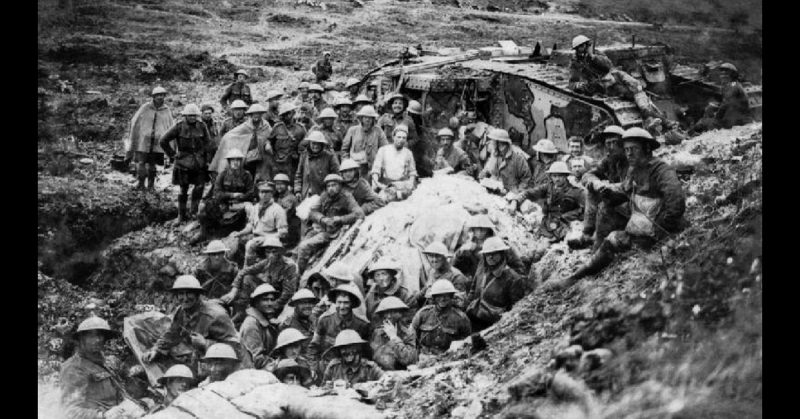On the Somme
The first use of tanks in an attack took place on September 13, 1916, during the Battle of the Somme. It was launched by British forces as part of an ongoing attempt to break through German lines at the mid-point of the First World War.
Shrouded in Secrecy
The arrival of the tanks was a closely guarded secret. The name “tank” played a part in this, as the British pretended the large objects being shipped across the Channel were water tanks rather than fighting vehicles. The units driving the tanks were not named as tank divisions or even cavalry, in case this would give the game away.
Encouraging the Troops
Despite this, British commanders wanted to prepare their forces for what was about to happen. On the morning of September 13, a message was relayed to the troops about to take part in the big attack. They were told a new and previously unused weapon was about to be unleashed. They were encouraged to make the most of the advantage this would bring, and advised they could take risks that might not normally be possible.
The British command was caught between the need for secrecy and the desire not to waste the opportunity, causing speculation among the troops. What was about to happen?
A Heavy Rhombus
The first tanks had a simple rhomboid shape with tracks running all the way around the outside. This lowered their height compared with previous test vehicles and allowed them to cross trenches with ease. They weighed 28 tons.
Unimpressive Engines
Unfortunately, the engines powering these machines were not very impressive. Their 105 horsepower allowed them to achieve speeds of only a mile and a half per hour when not on roads. The engines were unreliable and hungry for fuel, requiring a gallon of petrol for each 1.5 miles.
Lightly Armoured
The armor of the tanks in the first attack could not survive much more than small-arms fire. When machine-gun bullets hit, flakes of metal peeled off and went flying around the inside of the tank, adding to what was already a dangerous and unpleasant environment.
Protecting the Crew
The crew manning the tanks in the first attack wore leather helmets with goggles and chain-mail visors to protect their heads.
Chicken-wire Shields
The first tanks were fitted with chicken wire over the top, to protect them from grenade attacks. It quickly became apparent it was more of a hindrance than a source of protection, and it was abandoned.
Steering Group
Each tank was steered by the efforts of three men; the captain and two brakemen.
Each brakeman controlled the motion of the tracks on one side of the tank. The captain used compass bearings and the passage of time to try to work out where the tank needed to be, then used this to direct the brakemen.
Communication Difficulties
Radio communication had not yet been developed, so the tanks struggled to stay in contact with each other and with the men in charge. They had to use the same means of communication as the infantry; phone lines when these were available and in their absence carrier pigeons.
Not Enough Tanks
Field Marshal Haig wanted to use tanks to overcome the problem of taking and crossing enemy trenches. He wanted at least a hundred to make an effective attack, which he intended to feature in the launch of the Somme offensive on July 1.
Providing so many working tanks proved impossible. Two and a half months later, Haig still had only 49 tanks when the launch began in September.
Artillery Preparation
Before the attack the artillery bombarding the Germans changed their usual pattern trying to keep a path clear for the tanks. They left unshelled lanes across the ground under attack to enable the tanks to advance across less broken ground with the infantry following them.
Trouble Getting into Line
Even before the attack, the tanks ran into trouble. Seventeen failed on their way to the front. Seven more were unable to set out on the day. Of the 100 tanks Haig had hoped to use, he had 25.
Too Much Mud
Even with careful shelling, the ground was too difficult for many of the tanks. Two years of war had left the region around the Somme a broken wasteland. The rain had turned the ground into mud. Tanks had not yet reached a level of sophistication where they could deal with the terrain, and many became bogged down. It completely stalled the attack on High Wood.
D1
One of the most successful tanks that day was D1. The only tank to make it to Delville Wood, the very sight of it sent Germans running just before it reached their lines. The infantry following up behind it secured positions that had long anchored the German defenses on the edge of the wood. Having served so well, D1 was smashed by a German shell.
Ahead of the Tanks
The Infantry of the 41st Division were new to the line and inspired by the sight of these amazing new machines. They were following seven tanks but were so enthusiastic they reached the German trenches before the tanks.
A Relatively Large Success
Winston Churchill, one of the leading proponents of the tanks, was disappointed they did not achieve more on their first outing. However, by the standards of the First World War, it was a huge success for the British. They advanced over 2,000 yards, seizing German defenses. The vehicles boosted British morale and knocked that of the Germans in a continuing and horrific conflict.
Sources:
Martin Marix Evans (2002), Over the Top: Great Battles of the First World War.
Richard Holmes, ed. (2001), The Oxford Companion to Military History.
William Weir (2006), 50 Weapons that Changed Warfare.
